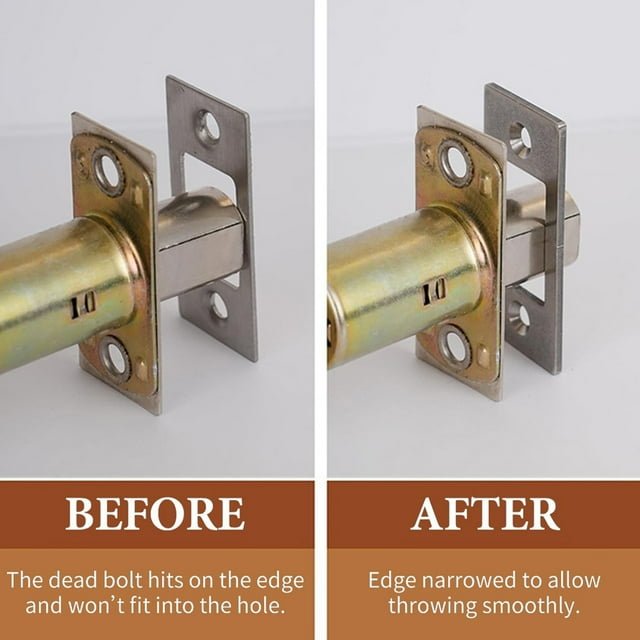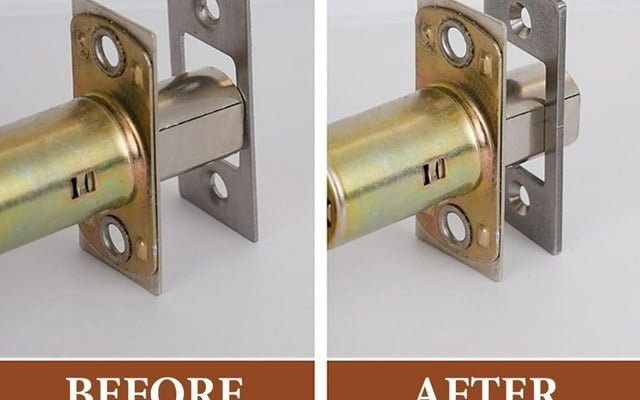
Here’s the thing: a deadbolt strike plate that’s been widened too much isn’t just annoying. It can actually make your lock useless and put your home’s security at risk. If you’re working with a standard Kwikset or Schlage deadbolt, or even something more modern, the challenge is the same. The good news? Fixing it is possible—even if you’re not a locksmith or a pro handyperson. All it takes is a bit of patience, the right tools, and a clear game plan.
Why a Widened Deadbolt Strike Plate Is a Problem
First, let me explain why that “little extra space” isn’t just a cosmetic issue. The strike plate lines up with the deadbolt, guiding the metal bolt into the door frame so the lock holds steady. When someone widens the opening—maybe to fix a misaligned door or because the bolt keeps sticking—they might create extra wiggle room. Over time, this slot can become a gaping gap.
What’s the risk? When the deadbolt doesn’t fit snugly in the strike plate, it’s way easier to force the door open. Even the best high-security deadbolt loses its power if the plate behind it is weakened or loose. In fact, many home break-ins happen because of strike plate problems, not because the lock itself is “bad.”
You might be wondering if tightening the screws or just using a longer deadbolt would help. Honestly, those fixes are usually temporary at best. Once the metal or wood around the strike plate is compromised, you’ll need a more serious solution to restore safety and function.
How to Tell If Your Strike Plate Opening Is Too Wide
Before you jump into repairs, you’ll want to check exactly what’s wrong. Sometimes the plate *looks* fine, but the lock doesn’t hold because of subtle wear and tear. Here’s how to size things up.
- Try locking your door normally. Does the deadbolt “grab” right away, or can you rattle the door even after locking it?
- Inspect the strike plate opening. If there’s a large gap around the deadbolt (more than a few millimeters), or visible wood on the edges, it’s definitely too wide.
- Check for loose screws or visible stripping. Often, over-widening comes with loose hardware or stripped-out screw holes—signs that the area needs reinforcement, not just cosmetic fixes.
Don’t forget to look at the door frame around the strike plate. Wood swelling, cracks, or chipping can all make the problem seem worse than it is. Comparing your setup to a properly installed plate on another door can help you spot subtle issues.
Simple Repairs: Filling and Redrilling the Strike Plate Opening
If the widening isn’t too dramatic and you’re handy with basic tools, you can often restore a strike plate with some wood filler or a dowel. Here’s a straightforward way to do it, using materials you can grab at any hardware store.
If you’ve got a couple of hours on a weekend and a steady hand, you’ll save yourself the cost—and hassle—of hiring a locksmith.
1. Remove the strike plate from the door jamb using a screwdriver.
2. Fill the gap: Use wood filler for smaller gaps (less than half an inch wide), or glue in a snug-fitting wooden dowel or toothpicks for larger voids. Make sure the filler is packed tight.
3. Let it dry fully—don’t rush this! Solid drying gives your patch the strength it needs to hold screws.
4. Sand everything smooth so the plate sits flush when reinstalled.
5. Redrill pilot holes for the screws, making sure they’re aligned straight and deep enough.
6. Reattach the strike plate and test your deadbolt. It should fit snugly, with no wiggle room.
This basic fix works for most wood frames and standard deadbolts (like Kwikset, Schlage, and Yale). If your frame is metal or the damage is extreme, you’ll want to read on for more advanced repairs.
Reinforcing a Weak Strike Plate With a Security Plate
Sometimes a simple fill-and-redrill won’t cut it—especially if the wood around the strike plate is damaged or the opening is huge. In these cases, it’s worth upgrading to a heavy-duty security plate. These plates spread force over a larger area and use longer screws, anchoring deep into the house frame.
Here’s what you’ll need:
- A reinforced security strike plate (available at any hardware store)
- 3-inch wood screws for extra holding power
- Chisel, drill, and a screwdriver
It takes a bit more work, but here’s the process:
- Remove the old strike plate and clean up the area—pry out any loose wood, dust, or filler.
- Chisel out a recess for the larger plate, matching its shape and depth.
- Position the security plate so the deadbolt lines up perfectly in the new opening. You might need to mark and drill new pilot holes.
- Install using long screws, going through the plate and deep into the stud behind the jamb. This is what truly strengthens your lock setup.
The end result is a strike plate that’s *way* harder to bust open—even if the previous opening was wide or rough. It’s a good “reset” for deadbolts on older doors or in high-traffic areas.
Alternative Fixes: Metal Shims, Strike Plate Adjusters, and Quick Patches
Not everyone wants to patch and chisel, especially if you rent or just want a quick fix. Thankfully, there are a few other tricks you can try to “tighten up” a deadbolt strike plate that’s been widened too much.
- Metal shims: Thin pieces of metal can be stacked behind the strike plate or inside the opening to make the fit tighter. It’s not pretty, but it works as a quick patch for smaller problems.
- Strike plate adjusters: These are little inserts or clip-on plates you can add to shrink the opening. They’re usually sold at hardware stores as “deadbolt repair kits.”
- Epoxy putty: For an emergency fix, a two-part epoxy putty can fill the gap quickly. Once it dries, sand it down and reinstall the plate.
Honestly, these “hacks” aren’t as sturdy as a proper wood fix or reinforced plate, but they’re sometimes enough to get your deadbolt secure—especially if you’re short on time.
When to Replace the Jamb or Call a Locksmith
Sometimes, no matter what you try, the area around the strike plate is just too damaged to repair at home. If the wood is crumbling, you can see daylight around the bolt, or you’ve tried several fixes without luck, it’s probably time for bigger action.
Signs you might need to replace the door jamb or call a pro:
- Huge cracks or splintering in the door frame
- Repeated repairs haven’t held up (the plate keeps coming loose)
- You can’t align the deadbolt even after adjusting the plate
- Security is an absolute priority—for example, on a rental property or business
A locksmith can often reinforce or replace the frame with professional-grade parts, or even install a metal “wrap” that covers the damage. And if you’re switching to a smart lock (like a Schlage Encode or Kwikset Halo), they may be able to customize the setup for extra security.
How to Prevent Widening Your Deadbolt Strike Plate Again
After you’ve gone through the effort of repairing your deadbolt strike plate, you probably don’t want to do it all over again. Here are a few smart ways to keep that strike plate slot tight and functional for the long haul.
- Keep your door aligned. If you notice your deadbolt is sticking or you have to “force” it, fix the alignment first—don’t just widen the opening.
- Use the right screws. Always use long, strong screws to anchor your strike plate. They hold better and resist pulling out.
- Check the fit regularly. Test your deadbolt every few months. If you start to feel slack or wiggle, deal with it early to avoid big repairs.
- Consider an upgrade. If you’re worried about break-ins, a heavy-duty security strike plate is a worthy investment and can outlast standard hardware.
It’s tempting to “make do” with a sloppy fix, but spending a little extra time now saves you headaches—and security worries—later.
Choosing the Right Repair for Your Situation
Every deadbolt strike plate issue is a little different. Some folks just need a quick patch, while others are dealing with serious long-term wear. Here’s how to think it through:
- Minor widening, tight budget? Wood filler or a dowel works great for most standard locks like Schlage and Kwikset.
- Big gap, heavy traffic area? Go for a reinforced security plate and long screws. It’s a permanent fix.
- Rental property or short-term need? Metal shims or strike plate adjusters can get you by for now.
- Serious damage? Don’t mess around—ask a pro or replace the frame for real peace of mind.
You might be tempted to just “shim it and forget it,” but honestly, nothing beats a solid, flush fit for your deadbolt in the long run.
Wrapping Up: A Strong Strike Plate Means Real Security
Fixing a deadbolt strike plate that’s been widened too much isn’t just about making your door close nicely. It’s about restoring real security to your home—the kind you can count on. Whether you use a bit of wood filler, install a reinforced plate, or bring in a locksmith for the big jobs, the end goal is the same: a tight, sturdy lock that keeps you safe.
So the next time your deadbolt feels wobbly, don’t just shrug it off or keep adjusting the plate. A little effort now pays off in peace of mind, every time you lock your door and walk away.
